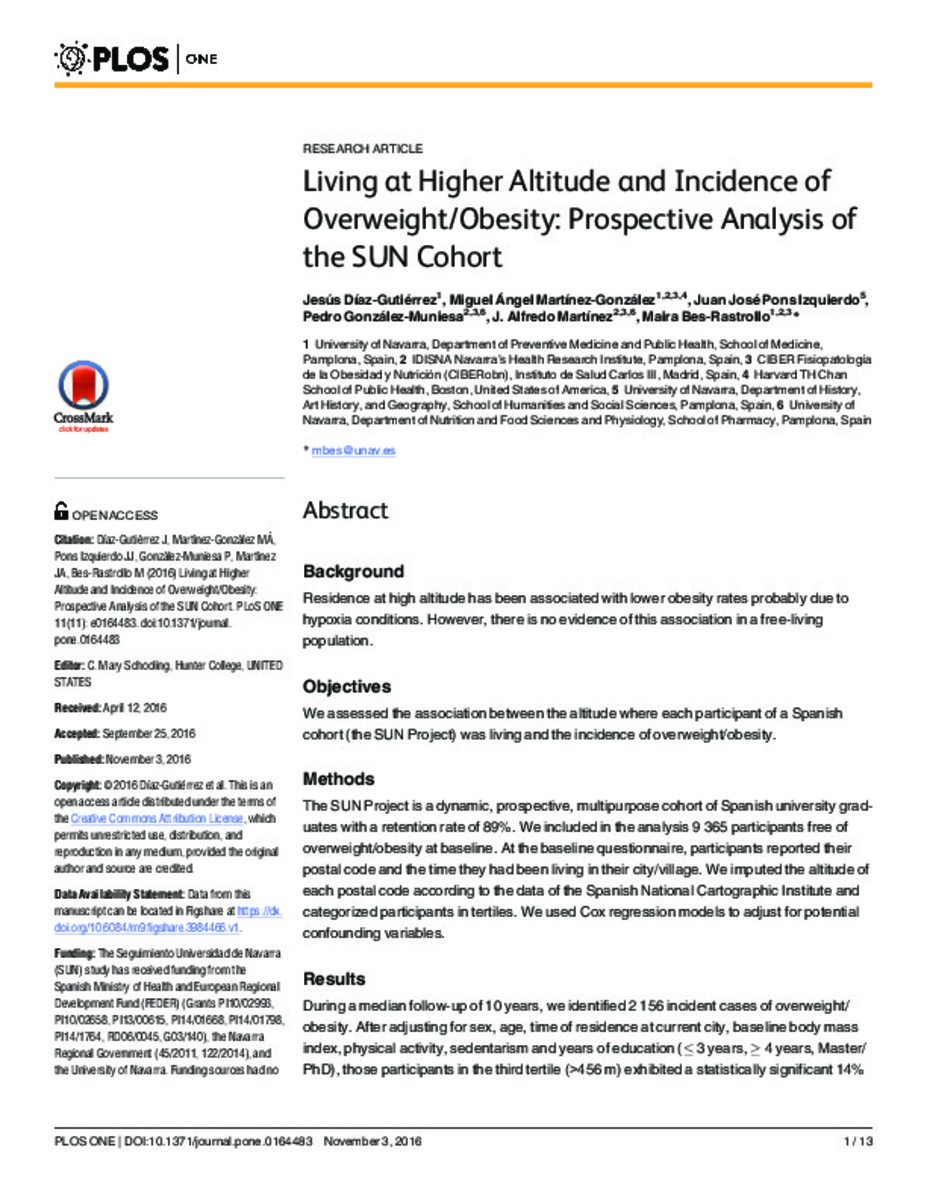Full metadata record
| DC Field | Value | Language |
|---|---|---|
| dc.creator | Bes-Rastrollo, M. (Maira) | - |
| dc.creator | Martinez, J.A. (José Alfredo) | - |
| dc.creator | Gonzalez-Muniesa, P. (Pedro) | - |
| dc.creator | Pons-Izquierdo, J.J. (Juan José) | - |
| dc.creator | Martinez-Gonzalez, M.A. (Miguel Ángel) | - |
| dc.creator | Diaz-Gutierrez, J. (Jesús) | - |
| dc.date.accessioned | 2017-03-10T07:57:50Z | - |
| dc.date.available | 2017-03-10T07:57:50Z | - |
| dc.date.issued | 2016 | - |
| dc.identifier.citation | Diaz-Gutierrez, J., Martinez-Gonzalez, M.A., Pons-Izquierdo, J.J., Gonzalez-Muniesa, P., Matinez, J.A., Bes-Rastrollo, M., Living at Higher Altitude and Incidence of Overweight/Obesity: Prospective Analysis of the SUN Cohort, PLOS ONE, 2016 Nov 3;11 (11). | es_ES |
| dc.identifier.issn | 1932-6203 | - |
| dc.identifier.uri | https://hdl.handle.net/10171/43073 | - |
| dc.description.abstract | BACKGROUND: Residence at high altitude has been associated with lower obesity rates probably due to hypoxia conditions. However, there is no evidence of this association in a free-living population. OBJECTIVES: We assessed the association between the altitude where each participant of a Spanish cohort (the SUN Project) was living and the incidence of overweight/obesity. METHODS: The SUN Project is a dynamic, prospective, multipurpose cohort of Spanish university graduates with a retention rate of 89%. We included in the analysis 9 365 participants free of overweight/obesity at baseline. At the baseline questionnaire, participants reported their postal code and the time they had been living in their city/village. We imputed the altitude of each postal code according to the data of the Spanish National Cartographic Institute and categorized participants in tertiles. We used Cox regression models to adjust for potential confounding variables. RESULTS: During a median follow-up of 10 years, we identified 2 156 incident cases of overweight/obesity. After adjusting for sex, age, time of residence at current city, baseline body mass index, physical activity, sedentarism and years of education (≤ 3 years, ≥ 4 years, Master/PhD), those participants in the third tertile (>456 m) exhibited a statistically significant 14% reduction in the risk of developing overweight/obesity in comparison to those in the first tertile (<124 m) (adjusted HR = 0.86; 95% CI: 0.77, 0.96). CONCLUSIONS: Living in cities of higher altitude was inversely associated with the risk of developing overweight/obesity in a cohort of Spanish university graduates. | es_ES |
| dc.language.iso | eng | es_ES |
| dc.publisher | Public Library of Science | es_ES |
| dc.rights | info:eu-repo/semantics/openAccess | es_ES |
| dc.subject | Materias Investigacion::Ciencias de la Salud::Salud pública | es_ES |
| dc.title | Living at Higher Altitude and Incidence of Overweight/Obesity: Prospective Analysis of the SUN Cohort | es_ES |
| dc.type | info:eu-repo/semantics/article | es_ES |
| dc.identifier.doi | http://dx.doi.org/10.1371/journal.pone.0164483 | es_ES |
Files in This Item:
Statistics and impact
Items in Dadun are protected by copyright, with all rights reserved, unless otherwise indicated.






